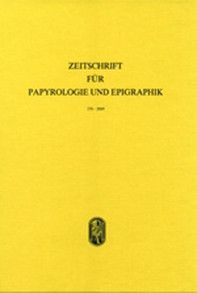
I have uploaded three new articles to the"Publications" page of this website, all of which were just published in Zeitschrift für Papyrologie und Epigraphik (ZPE). All three articles are "principal editions" of manuscript fragments.
One is an edition of some unidentified Fayyumic parchment fragments from the Michigan collection containing an inventory of religious vocabulary and a list of the disciples following Matthew's order.
Another is the full edition of a 3rd cent. C.E. Oxyrhynchus papyrus (P.Oxy. 560; Grenfell and Hunt only described it) that I co-authored with Andrzej T. Mirończuk, a Homeric scholar from Poland. I have written previously about this papyrus on this blog, introducing ahead of publication a scribal feature that appears only in P.Oxy. 560: a vertical ruling line. This is perhaps the most interesting feature of this papyrus, along with a new reading in Ψ 847.
The third is an edition of P.Col. inv. 257, a Ptolemaic documentary papyrus dated probably in the 3rd cent. B.C.E. and likely part of the dossier on Zenon. I have written previously about this papyrus here on the blog, highlighting a Greek word hitherto unattested. I discovered this papyrus by poking through the collection at Columbia. Given the early date of this papyrus, the previously unattested Greek word, the official nature of the document, and the possibility of its being associated with Zenon, I am very surprised that it has not been published prior to now.
One is an edition of some unidentified Fayyumic parchment fragments from the Michigan collection containing an inventory of religious vocabulary and a list of the disciples following Matthew's order.
Another is the full edition of a 3rd cent. C.E. Oxyrhynchus papyrus (P.Oxy. 560; Grenfell and Hunt only described it) that I co-authored with Andrzej T. Mirończuk, a Homeric scholar from Poland. I have written previously about this papyrus on this blog, introducing ahead of publication a scribal feature that appears only in P.Oxy. 560: a vertical ruling line. This is perhaps the most interesting feature of this papyrus, along with a new reading in Ψ 847.
The third is an edition of P.Col. inv. 257, a Ptolemaic documentary papyrus dated probably in the 3rd cent. B.C.E. and likely part of the dossier on Zenon. I have written previously about this papyrus here on the blog, highlighting a Greek word hitherto unattested. I discovered this papyrus by poking through the collection at Columbia. Given the early date of this papyrus, the previously unattested Greek word, the official nature of the document, and the possibility of its being associated with Zenon, I am very surprised that it has not been published prior to now.
